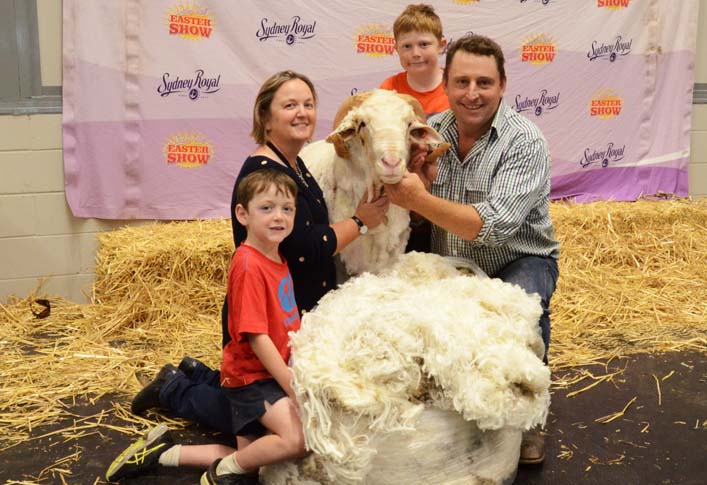Producing traditional fine wool sheep was never going to cut it for Michael Corkhill.
NICOLA BELL, The Weekly Times
August 23, 2016
Instead he wanted to produce “bulky” fine wool sheep focusing on fleece weight and performance to ensure profitability.
Michael and his wife, Jane, and their sons Toby, 6, and Hugh, 4, operate Grassy Creek Merino stud at Reids Flat, near Boorowa in NSW, with assistance from Jane’s parents Roger and Lis Webster.
From a sheep producing family, Michael always had an interest in Merinos, particularly ram breeding.
So in 2005 the Merino stud was registered, followed by the Poll Merino stud in 2007.
And while it might appear the Grassy Creek stud came up out of nowhere — especially if you look at the impressive results in the showring — Michael said there was “decades” of fine wool sheep breeding through his family behind their flock.
“I personally started breeding my own rams at 16, with 20 ewes in an artificial insemination program,” Michael said.
In 2007 Michael said they attended their first major sheep show, the Great Southern Supreme Merino in Canberra.
“I remember it vividly, we took three ewes and three rams and in the ewe class there were 15 ewes and we placed first, second and fifth and the rams placed first, second and third,” he said. “Maybe it was a bit of luck, but things went on from there.”
At Grassy Creek they now run about 1100 breeding ewes, as well as a commercial Merino flock and a Merino wether operation.
The wethers are shorn until about four years old and then sold for meat.
With only about 40 per cent of their property arable terrain, Michael said they were “very commercially focused” because they had to be.
“The sheep have to be able to walk well and survive in this climate,” he said.
The stud now consists of 75 per cent Poll Merinos and 25 per cent horned Merinos.
“I don’t think we will completely phase out the horned flock, but there used to be 30 per cent Polls and 70 per cent horned,” Michael said.
The Poll Merino stud was started with Grassy Creek horned ewes with the introduction of ewes from Pastora and genetics from the Middle View stud.
About 600 stud ewes were put through an artificial insemination program each year, with 300 using Grassy Creek rams and 300 outside genetics. The remaining 500 stud ewes are joined naturally.
Lambing was in August and September, with AI programs split up to spread the risk.
“We are at the mercy of the weather, so we like to have a few different lambings.”
Outside genetics used in recent years come from Langdene, Nerstane and the CentrePlus stud in NSW and Billandri Poll stud in West Australia.
At Grassy Creek the average micron is 17.5 across the flock and the fleece weight of maiden ewes averaged 7.7kg.
“We are trying to breed bulky fine wool sheep,” Michael said.
This means, fine wool sheep with a heavy wool cut, and a high growth carcass. Australian Sheep Breeding Values were introduced at Grassy Creek about three years ago. They currently measured nearly all they could including weaning weight, yearling weight, fleece weight, fibre diameter, fat, eye muscle area, with a focus on the Merino Plus Index.
“The next generation of Merino breeders want more than just the raw data now, although you still have to be stringent on physical traits,” Michael said.
Having started using ASBVs because clients were calling for it, Michael said they had noticed the difference in performance and about 50 per cent of clients at their ram sale now buying with assistance of the figures.
“Once you start measuring and performance recording, it is amazing the difference in results between the top and bottom sheep and difference in dollar value,” he said.
Fleece weight was one of the most important traits and as such rams and ewes were fleece weighed at 10 months and 1½ years to increase the accuracy of the figures.
The pedigree of all AI lambs was identified, for better accuracy and it gave the ability to link ewes to progeny and see how certain genetics performed.
Craig Wilson, who is well-known for his focus on commercial profitability, classes the Grassy Creek sheep.
In 2012 the Corkhills held their first on-property ram sale where they offered 66 rams and sold 63 for an average of $1750.
Last year they sold 220 rams in total, offering 96 at auction and selling 94 for an average of $2000, with rams going to NSW, South Australia and Victoria.
This year Michael said they would offer about 110 rams at their sale, which is on October 10.
For the past five years the stud has appeared in the top semen sales list, selling 560 doses of semen last year to every sheep producing state except Queensland.
“It is pretty amazing to have these results in a short period of time,” Michael said.
Showing was also an important aspect of the Grassy Creek business.
“The main reason we started to show was to get people to see our sheep.”
Having won grand champion ribbons at all of the major Merino shows, Jane said it was a “marketing and benchmarking tool rolled in to one”.








